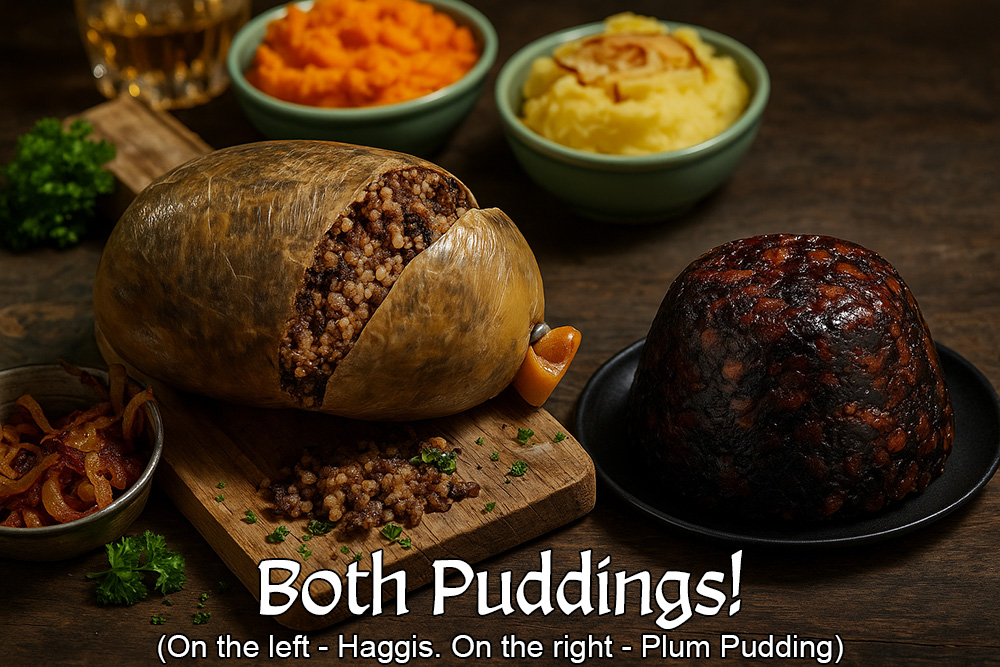Well actually sort of ... yes!

A classic pumpkin spice mix usually includes cinnamon, ginger, nutmeg, cloves, and allspice. Cinnamon is the foundational spice, while the others are often included in varying ratios. Some mixes also throw in mace or cardamom.
This mix is actually a long-standing recipe handed down loosely from over 250 years ago. Most of the pumpkin spice spices (and let's be clear we are talking about spices that have traditionally been used to flavor pumpkin pie not coffee, and not some mysterious mix in a jar from the store) were in fact the baseline flavorings for much of the cuisine of the British Isles from the 16th- through the 19th century. Several were sourced from the New World.
The average Scottish, Irish or English immigrant to North America would try to have pepper, ginger, cinnamon, nutmeg, mace, and cloves in their larder, if they could afford them. Spices such as nutmeg came from the West Indies so they were more affordable. Never the less, most cooks reserved their best spices for special holiday dishes. Like you know pies. Or more often, steamed puddings. Puddings wre a staple since they were something a cook could set up and let go all day while they performed other tasks. They were efficient as well as satisfying. Haggis is a pudding, as you probably already know.
Other spices used were allspice, anise seed, caraway, coriander, and fennel. Some cookbooks also mention less common spices like galangal and grains of paradise.
How Old Is Pumpkin Pie as a Dish?
As a matter of fact, "pumpkin pie" (using the name very loosely) goes way back. Recipes first appear in European cookbooks in the late 16th century, not long after pumpkins were brought back from the New World. But these torts (pies/tarts) were more of a main course or side dish by our standards, using the new exotic squash with things like onion, creamy cheeses, eggs, and sugar.
The British Isles versions were usually double-crusted and contained sliced, sometimes fried, pumpkin with other ingredients like apples, rosemary, sweet marjoram, and thyme.
A recipe from the English cookbook The Accomplisht Cook (1685), included a mix of spices that is starting to sound familiar: Cinnamon, Nutmeg, Cloves, Black pepper, Thyme, Rosemary and Sweet marjoram. Immigrants to the Americas took the dish in a new direction by essentially putting a smooth pudding in a single crust. The first such recipe appears in American Cookery by Amelia Simmons in 1796.

Speaking of puddings, what spices are included in the "Great Chieftain o' the puddin' race" Haggis?
You know where this is going.
The fundamental flavors in haggis come from salt, black pepper, and mace. But a classic haggis typically also includes some nutmeg, allspice and maybe coriander. More modern exotic haggises (Haggai?) may also include cayenne pepper, thyme, cinnamon, or even garam masala.
It's interesting to note that many pies in the 18th century used the crust as storage - a way to keep air and therefore bacteria out of the food. Single crust pipes were not as common. Meanwhile, the pudding reigned supreme. Puddings could be savory like haggis, or sweet like plum pudding, sweet potato pudding or the pumpkin pudding filling we mentioned above. Pumpkins and other squash were common fillers for immigrants living in the American colonies. Unlike in Europe, these were essential staples for colonists.
So what am I saying here? Well, first of all haggis and pumpkin pie are clearly cousins if you go back far enough. At some point in history, some grandma ran out of nutmeg because she was making both on the same day. And the pumpkin pie we know and love today evolved from immegrants combining the elements of pies and puddings with their favorite (and affordable) spices. This dish was adopted, eaten and passed down as "traditional." Like so many aspects of American culture, it was a joyful synthesis of old world preferences with new world resources.
So the next time you see someone slurping on a pumpkin spice latte, cut them a little slack. They may not know it, but their tastebuds are connecting with a rich culture that goes back hundreds of years.

So Why Not Add Haggis to Your Thanksgiving Dinner?
I am assuming that if you've read this far you like haggis and have had it before. But if you have not, welcome! You are in for a treat if you decide to explore this idea.
Some people will tell you that you can not get haggis in the United Sates. While, yes, the USA does have a ban on importing sheep lung (that is offal - organ meats - one of ingredients in a very traditional haggis) there are resources for getting haggis that is perfectly legal and delicious. We recommend the products of a little company called The Scottish Gourmet. They, like some other suppliers, make haggis using a traditional recipe BUT substitute the offal for other meats that are close to, if not identical, in favor and texture. Don't let anyone tell you that the offal is necessary for the flavor -- haggis is definitely all about the spices and the fat content.
Another option of course is to make your own haggis at home. As we said above, the haggis is in fact a boiled pudding. As such, there are several recipes online you can try -- some even do the cooking in a crockpot so they are especially easy.
But How Should You Incorporate Haggis Into Your Thanksgiving Offerings?
As a side of course! The flavor profile for haggis is savory, oaty, and peppery. If you have never had it, imagine a very rich, spiced meatloaf. It is thus a fantastic alternative side or can be offered alongside other Thanksgiving staples like stuffing and mashed potatoes. You could also go full-on Scottish and also swap in some neeps and tatties (ie. mashed swede and potatoes). But that might be best saved for Burns Night.
We have heard of people using haggis as a form of stuffing in the turkey, but this might be trying too hard. Rather we do like it as a side dish that offers a great counter-balance to something like sweet yams. So why not give it a try? And when the pumpkin pie comes along later, you can thrill your guests with your knowledge of the ancient history of "pumpkin spice".
Let Us Help You Present a Beautiful Celtic-theme Table Setting!
And finally let me make a shameless plug for USA Kilts' home goods. Your home should tell your story. And if that story includes a good dollup of Celtic heritage and pride (or just a love for Celtic design), we've got you.
From clan tartan table runners to Celtic and Norse wall art, every piece we offer is designed to bring warmth, texture, and a rich romantic feel to your space. In short — our home goods are about more than decoration. They’re about putting your passion front and center so you can enjoy it every day -- and especially when you have company.
Discover your clan’s tartan. Make your dining room a celebration of heritage.



